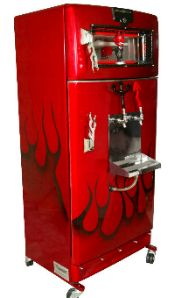|
This old kegerator
Content provided & sponsored by the Beverage Factory
"Why do you want a Kegerator? What the hell is a Kegerator? How can I build my own? What is there to maintaining it? All good questions we'll answer for you as you start down the spiritual path of draft beer enlightenment. Oh yes, Grasshopper, we have the answers you seek ..." - Beverage Factory
First step: Choose a refrigerator
Answer these questions before you shop:

"Devil May Care" custom Kegerator by www.Craigerator.com |
What type of refrigerator do you want?
There are various styles of refrigerators; you'll want to consider how many taps (Kegs) you plan to use. Keg sizes vary with manufacturer, but these dimensions will give you an idea what will fit in the frige you chose: 1/2 Keg - 15.5 gallons, 18-22" diameter; 1/4 Keg - 7.75 gallons, 16-20" diameter;
1/6 Keg - 5.16 gallons, 9-12" diameter
Used freezers are also usable for Kegerator conversion, adding the chest shape to your options. A freezer must be converted to a refrigerator using one of two(2) methods. 1) Replace the thermostat with the thermostat from a refrigerator, or opt for an external thermostat with a temperature sensor inside the box.
Where do you plan to put the refrigerator?
Measure the height, width and depth of the space the refrigerator will occupy. Keep that information and a tape measure with you.
New or Used?
New - Low cost import refrigerators are well established in the US appliance marketplace. Depending on your wants, needs, and budget, new might be the way you want to go. Low cost models start around $300. Refrigerators more than 10 years old may use more energy and cost more to run. Newer models use about one third less electricity.
Used - You see them at garage sales and swap meets. Used refrigerators are out there, waiting to be resurrected as beer dispensing machines. Here are a few tips to help you make an informed purchase.
Used refrigerator checklist:
Temperature. The refrigerator should be between 38-40 degrees Fahrenheit. The freezer should be 0 degrees.
Door gasket. Place a piece of paper between the door and the refrigerator. Can you pull it out easily? The door may not be closing tight enough to keep in the cold. The gasket may need to be replaced. Or the door hinges may need adjusting.
Working parts. Do the light and temperature control knob work?
Tips for transporting:
Be careful not to damage the coils on the back or bottom of the refrigerator.
Transport unit standing up if at all possible, avoid laying refrigerator down on its back or side.
Wait at least one hour after transporting to plug unit in to power.
Tips to cleaning your used refrigerator:
Avoid scratchy powdered cleansers or rough cleaning pads. For tough spots use baking soda with a damp towel. All-purpose liquid cleaner may be used.
To get rid of odors, wipe down with one tablespoon of baking soda to 1 quart of water. Rinse, then wipe dry.
Is the door gasket mildewed? Wipe with a mixture of 1/4-cup chlorine bleach to 1-quart water. Wipe and towel dry. Do not use bleach on other parts of the refrigerator. It may cause plastics to yellow.
Condenser coils are located to the back or underneath the refrigerator. Clean them at least once a year. Vacuum and wipe with damp cloth. Also, clean the drip pan if there is one.
What's next?
- Choose a kit
- Build your dream draft machine
- Care and maintenance
- Common draft questions
| 
